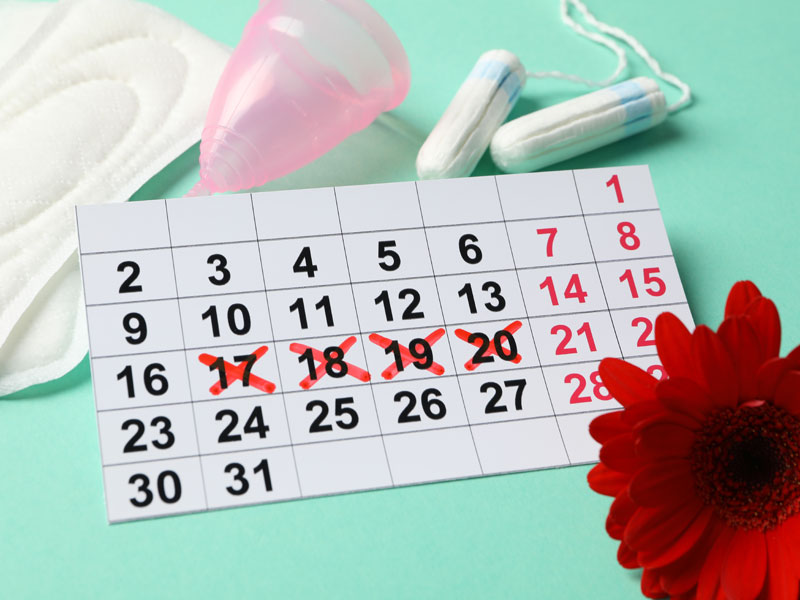
Understanding your menstrual cycle is not just about tracking when your period arrives. It involves recognizing the complex biological processes your body undergoes each month. This awareness can
- empower you to manage your reproductive health,
- anticipate hormonal fluctuations that affect your mood and energy levels, and
- even enhance your chances of conception if desired.
Let’s start with the phases of a menstrual cycle.
The Four Phases of Menstrual Cycle
You can divide your menstrual cycle into four primary phases, each characterized by hormonal changes and physiological processes.
1. Menstrual Phase
The menstrual phase marks the start of the cycle, beginning on the first day of menstruation and lasting 3 to 7 days.
The uterus sheds its lining during this time, resulting in menstrual bleeding. This phase occurs because the egg released during the previous cycle was not fertilized, which prompts a drop in estrogen and progesterone levels and stimulates the shedding of your uterine lining. In other words, you are not pregnant!
2. Follicular Phase
Following menstruation, the follicular phase begins and overlaps with the tail end of the menstrual phase.
This phase is characterized by your hypothalamus signaling the pituitary gland to release follicle-stimulating hormone (FSH), which stimulates your ovaries to produce several follicles. Each follicle contains an egg. Typically, only one follicle will mature into an egg, while the rest will recede. This phase ends with the start of ovulation.
3. Ovulation Phase
Ovulation is a pivotal part of the menstrual cycle.
Triggered by a surge in luteinizing hormone (LH), ovulation involves the release of a mature egg from your ovary into your fallopian tube, where it can potentially meet sperm for fertilization. Ovulation usually occurs around the middle of the cycle.
4. Luteal Phase
The luteal phase begins after ovulation and lasts until menstruation starts.
The ruptured follicle transforms into the corpus luteum, which secretes progesterone to thicken the uterine lining in preparation for a possible pregnancy. If fertilization does not occur, the corpus luteum degenerates, leading to a decrease in progesterone and eventually the onset of menstruation (phase 1).
Managing Fluctuating Energy Levels During the Menstrual Cycle
During menstruation, you can feel tired and lethargic. This improves as estrogen levels rise in the follicular phase. Energy might peak around ovulation, then taper off in the luteal phase as progesterone increases – often leading to premenstrual fatigue.
Here are tips to help manage these changes:
- Increase iron intake during menstruation, stay hydrated, and eat small, frequent meals to stabilize energy.
- Opt for gentle exercises during menstruation, more vigorous activities in the follicular phase, and relaxation techniques in the luteal phase.
- Maintain a regular sleep schedule and create a restful bedroom environment.
- Adjust daily activities based on your energy levels
Common Period Pain Causes
Period pain – dysmenorrhea – can stem from various causes, primarily the production of prostaglandins. These are compounds involved in pain and inflammation, which trigger muscle contractions in the uterus, causing pain and discomfort.
Secondary causes include conditions like endometriosis or fibroids, which can exacerbate pain during menstruation.
To manage period pain effectively, you can try the following:
- A heating pad or hot water bottle on your lower abdomen.
- Aerobic exercises to release endorphins.
- Foods rich in omega-3 fatty acids, magnesium, and vitamins B1 and E before your menstruation phase.
- Non-steroidal anti-inflammatory drugs (NSAIDs) such as ibuprofen
How to Calculate Cycle Length
Calculating your cycle length is fundamental in tracking your menstrual health.
Begin by marking the first day of your period on a calendar. The cycle continues until the day before your next period starts. Counting these days gives you the cycle length, which can vary from month to month.
There are many digital tools and apps out there that can simplify tracking your menstrual cycle. However, most apps are not based on significant evidence, according to recent research of apps in the Apple Store and Google Play Store.
However, these apps often allow you to record symptoms, mood changes, and other health data, providing you with a helpful overview.
Understanding Ovulation for Fertility Awareness
At Stella Mattina, we’re happy to discuss your family planning and birth control needs. For fertility planning it’s important to understand when ovulation occurs.
Methods to track ovulation include:
- Basal Body Temperature (BBT) Tracking: Recording your body’s lowest resting temperature daily can help detect the slight increase after ovulation.
- Cervical Mucus Observation: Checking changes in cervical mucus throughout the cycle can provide clues about your fertile window, with mucus becoming clearer and stretchier as ovulation approaches.
- Ovulation Predictor Kits: These kits test your urine for luteinizing hormone surges, indicating imminent ovulation.
Signs Ovulation Is Over
Recognizing the end of ovulation can help you understand your fertility window. Common changes concern:
- The consistency of cervical mucus (it becomes drier instead of stretchy and slippery).
- Basal Body Temperature returns to normal after the slight increase during ovulation.
- Libido decreases as you re-enter the luteal phrase.
- Possible abdominal pain as you begin menstrual phase 1.
Is It Possible to Ovulate Early?
Ovulating early can happen, especially if you’re under stress, you are ill, or have irregular sleep patterns.
Common Menstrual Irregularities
Finally, let’s look at some of the most commonly asked questions we get at Stella Mattina so we can put your mind at rest. As we always say, knowledge is power!
Why does my period keep stopping and starting?
Irregularities, such as a period that starts and stops, can be frustrating and confusing. This can be caused by:
- Hormonal imbalances
- Stress
- Significant weight change
- Underlying health conditions like polycystic ovary syndrome (PCOS)
Why are my cycles getting shorter?
As you age, especially approaching menopause, you can experience shorter cycles. Other factors like stress and lifestyle changes can also influence cycle length. If you’re noticing a significant change, such as a cycle that consistently falls short of 21 days, consult a healthcare professional.
Can you ovulate without a period?
Yes, this can happen when you have very irregular cycles or a condition like PCOS. When ovulation doesn’t happen consistently, it can be challenging to predict fertility without additional tracking methods.
Mastering Your Menstrual Cycle and Health with Stella Mattina
Understanding your menstrual cycle goes beyond just knowing when your period starts. It’s about recognizing the intricate balance of hormones and physiological changes that your body experiences.
At Stella Mattina, we’re completely dedicated to helping women with everything to do with their health and wellness. If you’re at all worried about your menstrual cycle or have more questions, please make an appointment. You won’t have to wait long and we accept most insurances. Let’s talk.
Dr. Krum is currently in practice in Arlington, TX. He received his undergraduate degree at Texas A&M University, then attended UTMB Galveston for medical school, finishing in 1986, completing his residency there in 1990. Providing a full range of obstetrical and gynecological care, he specializes in the treatment of endometriosis and robotic surgery. He arranges his schedule so that same-day appointments are usually available.
